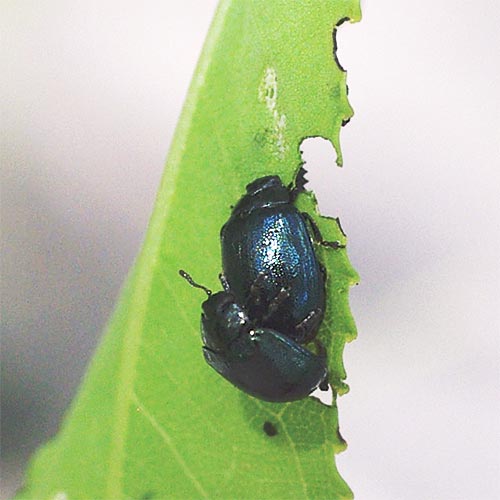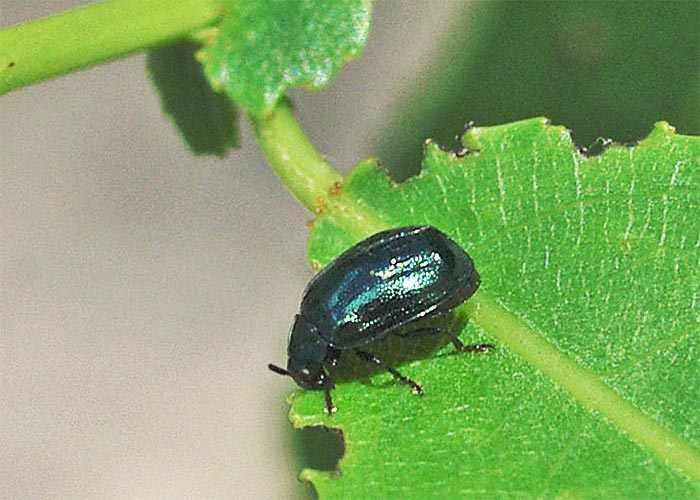Howdy, BugFans,
Scientists around the globe have been studying the heck out of the Imported Willow Leaf Beetle, a.k.a the Willow Leaf Beetle (Plagiodera versicolora) (which is, not surprisingly, in the Leaf beetle family Chrysomelidae). These northern European natives reached our shores in 1915; they’re common in the eastern half of the U.S. (there are scattered reports in the West) and north into Canada. Scientists in a number of European countries are scrutinizing them, and there’s also a fair amount of research being done on them in Japan, where these little immigrants are apparently unappreciated. IWLBs are tiny (less than ¼ inch), metallic-blue-green beetles that, as both larvae and adults, eat willow and poplar and often feed in groups.
Adults overwinter in bark crevices or on the ground in leaf litter, and they leap into action when trees begin to leaf out. After munching on a few spring greens, females lay bunches of yellow eggs on the undersurfaces of leaves—up to 750 eggs, in “clutches” of about 50 eggs each. The eggs hatch quickly, and a few days later, herds of larvae can be found skeletonizing leaves from below—eating the tender, green tissue between the veins. Older larvae will feed on the leaf’s upper surfaces, too. Mature larvae “go walkabout” for a brief spell before picking a spot to pupate. There can be several generations per year, but by early fall, the adults of the final brood start tucking themselves in for the winter.
The sleketonized/semi-skeletonized leaves turn brown, but unless a tree has a heavy infestation for several years in a row, the threat they pose is more cosmetic than deadly. If it has fed a lot of larvae, a tree may look scorched by August, and its leaves may fall early. The adults eat the same food plants as their larvae, producing holes or notches in tender, new leaves.
IWLBs have some natural enemies in the forms of parasites and parasitoids, and a few predators like Asian Ladybugs, which eat IWLB eggs, and Assassin bugs, which eat the larvae, but the ministrations of these bugs doesn’t seriously dent the IWLB population.
Scientists around the globe have been studying the heck out of the IWLB. What have they discovered? Here are a few IWLB FAQs, based on some of the many research projects in which they’ve starred:
- Q: Do IWLBs prefer to eat young leaves or older ones?
A: IWLBs are very choosy. They not only prefer younger leaves, but they restrict themselves to a narrow age range in the leaves they eat. IWLB larvae grow faster and larger on a diet of young leaves. - Q: How do they find their food?
A: By smell. Apparently, the odor of chewed leaves is different from that of un-chewed shoots, and IWLB larvae prefer their leaves un-chewed (a hungry beetle, though, prefers a leaf that smells as though some other IWLBs have been feeding there). IWLBs fancy the scent of willow leaves above that of fresh air. - Q: Do IWLBs favor some species of willow over others?
A: Yes. Willow leaves have differing concentrations of salicylate, depending on the willow species (salicylate is the aspirin pre-cursor, and willow leaves have been used medicinally for millennia. According to folklore, the more salicylate a leaf contains, the more bitter and “medicinal” the plant is). IWLBs prefer low-salicylate species. Several studies indicate that they also favor first-generation willow hybrids. Sometimes the species they prefer to eat is not the one that maximizes their growth and reproductive performance. - Q: Willow leaves have a lot of roughage – is there a downside?
A: There certainly is. Leaves tend to get tougher with age. Chewing on heavy-duty willow leaves wears down an IWLB’s mandibles/mouthparts, which results in a slower feeding rate, which results in a lower rate of egg laying. - Q: Are IWLBs affected by a willow tree’s phenology?
A: Absolutely! If a female is going to lay eggs, she must continue eating, but trees make fewer of the tender, desirable leaves as the season passes. Some species of willow shut down earlier than others, and IWLBs will move to those that are still sprouting new leaves. As the season wanes, so does fertility. - Q: IWLB larvae prefer each other’s company. How do they find other IWLBs to hang out with?
A: Larvae are attracted to a milieu that includes the familiar secretions, frass (bug poop), and physical presence of others in their cohort. BugFans who guessed Facebook or Twitter get a demerit. - Q: When female IWLBs tuck themselves in for the winter, what’s their marital status?
A: Polygamous and gravid. Females mate with several males in fall, before entering diapause (a period of inactivity), and most females emerge from diapause in spring primed to lay fertile eggs. - Q: Tough Love?
A: In spite of the fact that her larvae clearly prefer young, tender leaves, Mom oviposits on older vegetation. In her research, S. L. Gross discovered that the larvae that hatched from eggs placed on older leaves had a below average growth rate but that the eggs had a higher hatching rate (egg predators are more common on the younger, upper leaves, and the “harsher” weather at the top of a stalk is harder on the eggs).
- Q: Seriously? IWLBs have a chemical defense system?
A: According to Eisner in Secret Weapons, “Its [Plagiodera’s] larva has nine pairs of glands, arranged segmentally along the sides of its body. The glands consist of pouches replete with fluid, ordinarily kept withdrawn, but promptly everted when the larva is prodded or pinched.
The P. versicolora larva upgrades its response in accord with the intensity of the stimulus. If the larva is seized bodily with forceps and lifted off the substrate, it is likely to evert all glands at once. If, however, it is subjected to a localized stimulus such as the pinching of a leg, it may restrict its response to the eversion of the glands closest to that leg …Typically, following the cessation of the stimulus, the glandular sacs, together with the extruded droplets, are pulled back into the body. Loss of secretion is thereby held to a minimum.
The secretion of P. versicolora is potently repellent to arthropod predators… Interestingly, the P. versicolora secretion, in addition to deterring predators, may have repellant effects on competing herbivores that feed on the same plant.
More that you ever realized that you wanted to know about IWLBs. There will be no quiz.
The Buglady

